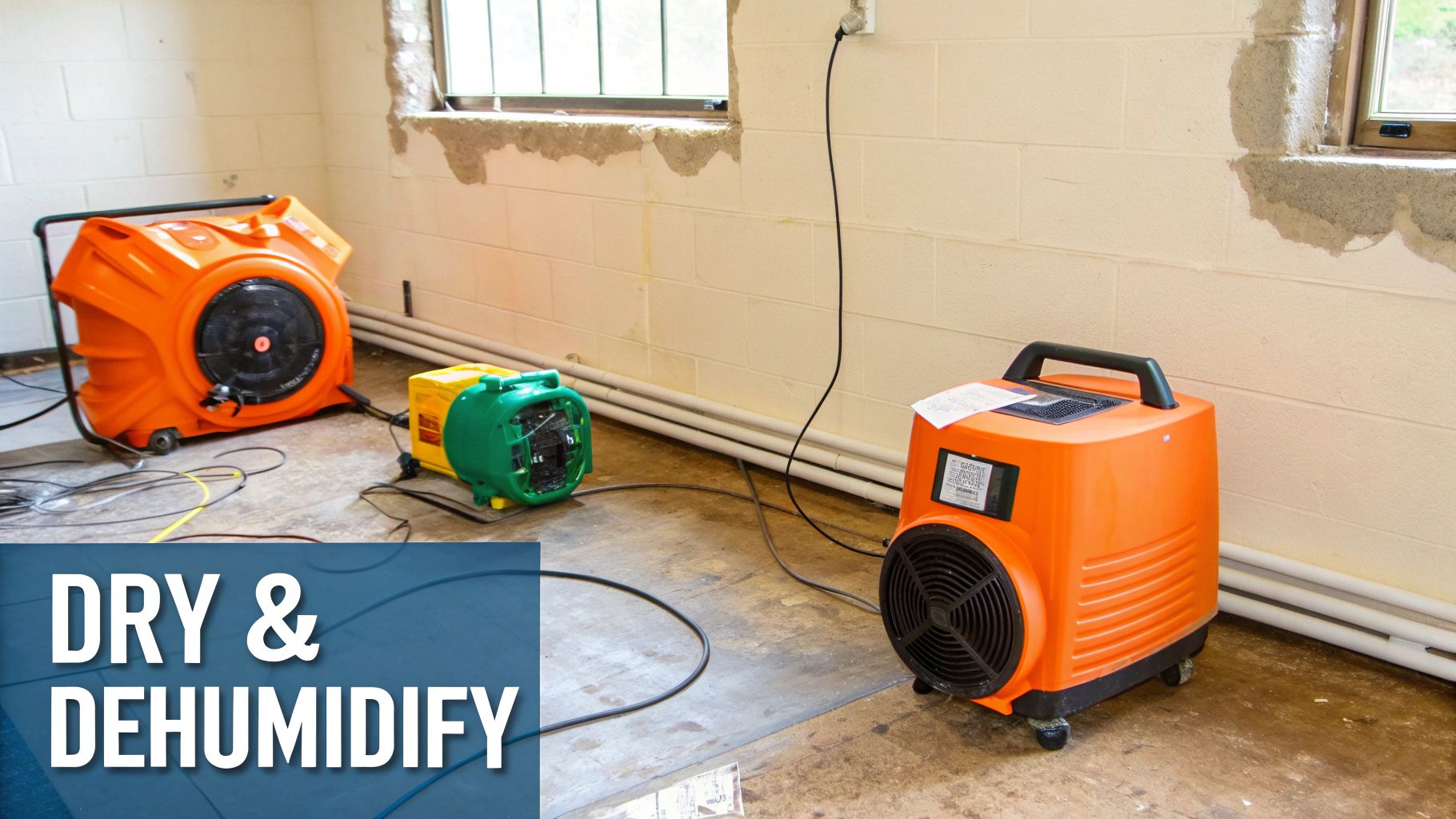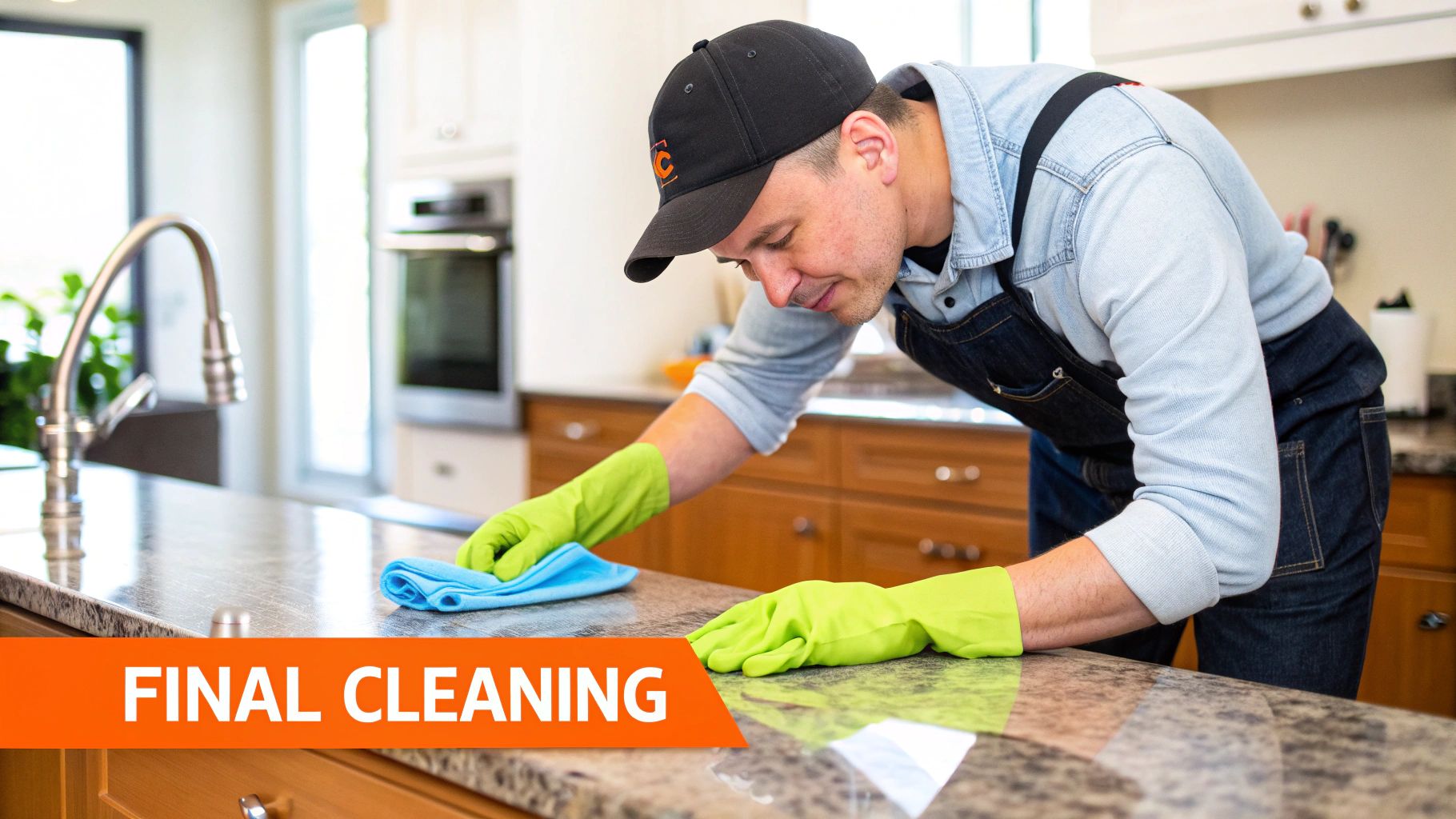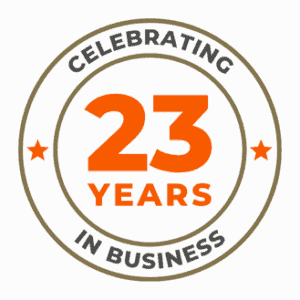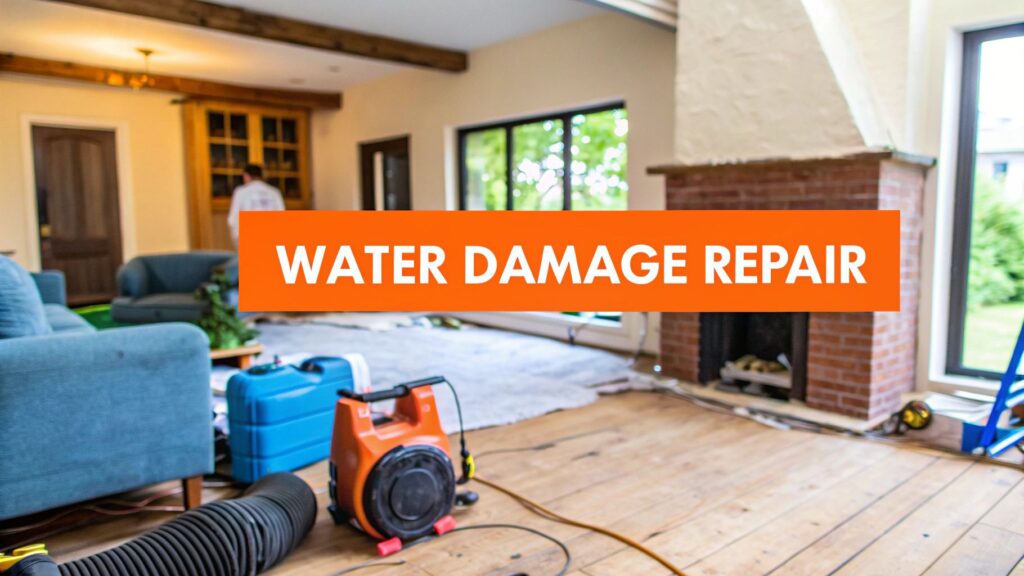When you discover water spreading across your floor, the clock starts ticking—fast. Your immediate response in those first few moments is critical, setting the stage for the entire home restoration from water damage process and influencing everything from the final cost to the long-term health of your property. For homeowners in Orange County, from Newport Beach to Irvine, a fast, knowledgeable reaction can turn a potential catastrophe into a manageable project.
Your First 48 Hours: A Strategic Water Damage Action Plan
The initial discovery of water damage can be stressful. Whether it’s a burst pipe flooding your kitchen or a slow appliance leak, the feeling of being overwhelmed is universal. However, panic leads to mistakes; a clear, deliberate plan is what puts you back in control. At Sparkle Restoration Services, our mission is to turn chaos into calm, starting with these first essential steps.
The absolute first priority is safety. Before grabbing a mop, you must address the electrical risk. If you see standing water, go directly to your home’s main circuit breaker and shut off the power. This is a non-negotiable, life-saving step. Once the area is electrically safe, and if you can reach the source without risk, shut off the main water valve to your house to stop the flow.
Securing The Scene and Documenting Damage for Your Claim
With the immediate dangers handled, your role shifts to that of a detective—a crucial step for your future insurance claim. Using your smartphone, take extensive pictures and videos of everything. Do not move any furniture or belongings yet.
Capture the water source, the extent of the standing water, and every single item it has touched—flooring, walls, furniture, and personal effects. Get wide shots for context and close-ups from multiple angles. This detailed documentation is your “before” evidence for the insurance adjuster and your most powerful tool for proving the full scope of the damage.
Water damage is a shockingly common problem. In fact, nearly 14,000 Americans face a water damage emergency every day, making it a leading cause of property insurance claims. The stakes are high because water doesn’t just sit; it soaks into structural materials, creating an immediate risk of mold and rot. Waiting can drive up repair costs by 30-50% if not addressed within the first 48 hours.
Expert Insight: “As an IICRC Master Certified firm and a BBB Torch Award Winner for ethics, we’ve managed countless restoration projects in Orange County. The most successful outcomes always begin with smart, swift decisions made in the first few hours. Securing the property and documenting the initial damage sets a strong foundation for a smooth recovery.”
The first hour is critical. This prioritized checklist will guide your actions.
Immediate Water Damage Action Checklist
| Priority | Action Item | Reason |
|---|---|---|
| 1 (Highest) | Shut Off Power at the Main Breaker | Prevents electrocution risk from standing water and submerged electronics. |
| 2 | Shut Off the Main Water Valve | Stops more water from entering and causing further damage. |
| 3 | Document Everything with Photos/Videos | Creates indisputable evidence for your insurance claim before anything is moved. |
| 4 | Call a Professional Restoration Company | Their team can start the mitigation process immediately, 24/7. |
| 5 | Contact Your Insurance Company | Opens the claim and gets the official process started. |
Following these steps in order helps transform a chaotic situation into a managed response, protecting both your safety and your property.
Making The Right Calls
Once the scene is stable and documented, it’s time to bring in certified experts. If you have a plumbing issue and are unsure of the source, your first call might be to a specialist for finding a reliable plumber to stop the leak permanently.
However, your most important call is to a full-service, certified water damage restoration company like Sparkle Restoration. Our IICRC Master Certified technicians are on call 24/7 throughout Orange County, ready to begin the mitigation and drying process immediately. Time is your enemy, and professional expertise is your greatest ally.
The infographic below breaks down the key steps to take as soon as you discover a water issue.

As you can see, the process is built on three pillars: safety first, then documentation, then professional intervention. Preparation makes a world of difference. For a deeper dive into readiness, explore our guide for assembling a water emergency first aid kit. These measured actions are what turn a crisis into a manageable problem.
How Certified Professionals Assess and Extract Water
Once you’ve made the property safe and called for backup, the technical phase of your home restoration from water damage begins. The moment our Sparkle Restoration Services team arrives at your Orange County home, we shift from damage control to a strategic recovery mission. This is about more than just removing visible water; it’s a meticulous, science-driven process.

We always begin with a comprehensive assessment to determine the true scale of the problem. Water is deceptive; it can travel under baseboards, saturate wall cavities, and wick into subflooring far from the original source. A visual inspection is never sufficient to protect your home from long-term issues like mold and structural decay.
Uncovering Hidden Moisture with Advanced Technology
To see what the naked eye cannot, our IICRC Master Certified technicians deploy a suite of diagnostic tools. This equipment allows us to accurately map the extent of water migration, ensuring no hidden pocket of moisture is left behind to cause problems later. It’s like giving your home an MRI to reveal damage hiding beneath the surface.
Our assessment toolkit includes:
- Thermal Imaging Cameras: These cameras reveal temperature differentials in walls, floors, and ceilings. Wet areas are cooler than dry ones, allowing us to quickly pinpoint water intrusion without destructive testing.
- Moisture Meters (Penetrating & Non-Penetrating): We use non-invasive meters for quick surface readings. For deeply saturated materials like wood studs or subflooring, we use penetrating meters with probes to get precise data on the moisture content deep within.
- Hygrometers: These devices measure the humidity in the air, telling us how much moisture must be removed from the environment to achieve a proper drying standard.
This detailed data collection separates a professional restoration from a simple cleanup. It becomes the blueprint for our entire drying strategy and provides you with the hard evidence needed for your insurance claim.
Turning Chaos Into Calm: “The assessment phase is where we build the roadmap for recovery. By precisely identifying every affected area, we can target our efforts efficiently, shorten the restoration timeline, and give homeowners the peace of mind that the job will be done right the first time.”
The Science of Professional Water Extraction
With a clear damage map, we begin extraction immediately. The goal is simple: remove as much standing and absorbed water as quickly as possible. Every gallon extracted with our equipment is a gallon that doesn’t need to be evaporated later, drastically reducing the overall drying time.
Our equipment is far more powerful than anything available for rent. If a living room in a Newport Beach home has saturated carpeting, we will deploy a truck-mounted extraction unit. This machine uses powerful suction to pull water not only from the carpet fibers but also from the soaked padding beneath.
For more severe scenarios, like a flooded Irvine basement, the strategy evolves:
- Submersible Pumps: For more than a few inches of standing water, we use high-capacity submersible pumps that can move hundreds of gallons per hour out of the building.
- Industrial-Grade Wet Vacuums: After the bulk of the water is removed, we use specialized wet vacuums to handle remaining puddles and extract excess moisture from hard surfaces like concrete or tile.
This powerful, methodical extraction is the most critical first step in halting the damage. It stops further water absorption, minimizes the risk of secondary damage, and sets the stage for the sophisticated drying and dehumidification process to follow.
Drying, Dehumidifying, and Preventing Mold Growth
Once the standing water is gone, the real science begins. This is where many homeowners develop a false sense of security. Removing visible puddles is one thing, but it’s the hidden moisture—the water absorbed deep into drywall, wood framing, and subfloors—that poses the greatest long-term threat. This unseen moisture is a perfect breeding ground for mold.

A common mistake we see in Southern California is opening windows and using box fans. While well-intentioned, this approach is rarely sufficient and can worsen the situation. It fails to address deeply absorbed moisture and can introduce more humidity from outside, slowing the process and increasing the risk of secondary damage.
The Science of Structural Drying
Properly drying a structure is a science known as psychrometry—the study of the relationship between air, temperature, and humidity. Our IICRC Master Certified technicians don’t just place equipment randomly; we engineer a controlled drying environment inside your home, tailored to your specific situation.
We begin by strategically placing high-velocity air movers to create a powerful, circulating airflow across all wet surfaces.
This achieves two critical goals:
- It accelerates evaporation, pulling moisture out of porous materials like drywall and wood and converting it into water vapor.
- It keeps the air in constant motion, preventing damp, stagnant pockets where mold can begin to grow.
However, all that airflow just moves moisture into the air. That’s where professional dehumidifiers come in—they are the true workhorses. A single commercial-grade Large Loss Dehumidifier (LGR) can remove over 25 gallons of water vapor from the air in a single day.
Expert Insight from Sparkle Restoration: “We often explain to our Orange County clients that we are essentially creating a ‘drying chamber’ inside their home. By manipulating temperature, airflow, and humidity, we can force moisture out of the very bones of the building, ensuring a thorough and permanent dry-out that protects the home’s long-term integrity.”
The Critical 24 to 48-Hour Window for Mold Prevention
From the moment water intrusion occurs, the clock is ticking. Mold spores are always present in the environment, waiting for moisture to activate. The window between 24 and 48 hours after a water event is absolutely critical for preventing a major problem. If moisture levels are not controlled within this timeframe, the likelihood of a significant mold infestation increases dramatically.
This is precisely why our 24/7 emergency response is so crucial. By starting the drying process immediately, we can often stop mold before it gets a foothold, saving you the stress and expense of a more complex remediation job later. If you suspect mold is already present, it is vital to engage a certified professional. Learn more about our specialized Orange County mold remediation services to understand why this requires an expert approach.
Monitoring for a Complete Dry-Out
Setting up the equipment is only the beginning. Our work is not complete until we can verify that your home is dry. Our technicians return daily to monitor progress using the same advanced tools from our initial inspection—thermal cameras, moisture meters, and hygrometers.
We take detailed readings from affected materials and the air, adjusting equipment placement and settings as needed to optimize the drying process.
We don’t guess when your home is dry; we prove it with data. We continue this process until every affected material, from the drywall surface to the core of the subfloor, has returned to its normal, pre-loss moisture content. This scientific verification provides you—and your insurance carrier—with the peace of mind that the job is truly complete and the risk of future problems has been eliminated.
Even with professional intervention, knowing how to use an effective mildew remover for carpets can be useful for addressing any lingering musty odors. Ensuring your home is not just structurally sound but also healthy is the final step before moving to the repair phase.
Navigating Structural Repairs and Restoration
Once your property is verifiably dry, we transition from mitigation to reconstruction. This is the phase where your house starts to feel like a home again. It’s also where having a Licensed General Contractor on your team is indispensable. We’re not just patching things up; as a full-service design-build firm, we meticulously rebuild your home, ensuring every detail is safe, structurally sound, and beautifully finished.
https://www.youtube.com/embed/bFhnvRRPq3o
The first step is a comprehensive damage assessment. Our team inspects every material that was exposed to water. While solid wood framing can often be saved after proper drying, other materials are not as resilient. Anything that has lost its structural integrity or could harbor mold must be removed.
Assessing What to Salvage and What to Replace
Determining what to keep and what to discard is a critical judgment call, guided by IICRC standards and building science. If a material has swollen, warped, or begun to delaminate, it is almost always a lost cause.
Common materials requiring replacement include:
- Drywall and Insulation: Once saturated, drywall becomes weak and brittle. Wet insulation loses its R-value and becomes a magnet for mold. In nearly all cases, these must be removed and replaced.
- Flooring: Materials like laminate, engineered wood, and especially carpet padding are notorious for trapping moisture and deteriorating. They are rarely salvageable. Solid hardwood has a better chance and can sometimes be refinished, depending on the extent of the warping.
- Cabinetry: Common particle board or MDF cabinets found in many kitchens and bathrooms absorb water like a sponge and lose their structural integrity. Solid wood cabinets fare better but require careful inspection.
This selective, strategic demolition is non-negotiable. It ensures that when we rebuild, we are doing so on a solid, clean, and stable foundation.
A General Contractor’s Perspective: “The reconstruction phase is more than just repair work; it’s an opportunity. We help our Orange County clients see this challenging time as a chance to make thoughtful upgrades they’ve always wanted, turning a disaster into a value-adding home renovation.”
Rebuilding From the Ground Up
The rebuild is a layered, methodical process. We start with core structural elements and work our way out. For instance, if a dishwasher leak damaged your kitchen, the process would look like this:
- Subfloor Integrity Check: We first inspect the subfloor for any signs of rot or weakness. A compromised subfloor is a safety hazard and must be repaired or replaced before anything else proceeds.
- Framing and Electrical: Next, we replace any damaged wall framing. This is also the ideal time to inspect electrical wiring. If any was affected, we ensure it is safe and brought up to current code.
- Insulation and Drywall: With the wall structure in place, we install new, high-quality insulation, followed by fresh, moisture-resistant drywall, which we tape, mud, and sand to a seamless finish.
- Flooring and Cabinetry: Now for the visible transformation. Once the walls are ready, we install the new flooring. After that, base cabinets and countertops are put in place.
- Finishing Touches: To complete the project, we install upper cabinets, apply a fresh coat of paint, connect plumbing and appliances, and add all the final trim work.
An Opportunity for Thoughtful Remodeling
While no one wishes for water damage, it presents a unique silver lining: the chance to remodel. Since flooring, drywall, and cabinets often require replacement anyway, many of our clients in affluent Orange County communities decide to invest a little more to finally create the kitchen or bathroom they’ve been dreaming of.
We see it all the time. A project that begins as an emergency response to a pipe leak can evolve into a beautiful, high-end remodel. Our recent work on a water damage restoration in an Irvine home is a perfect example. What started as a chaotic mess became a stunning, modern living space that added significant value to the property.
As a BBB Torch Award-winning company, we handle this entire process seamlessly. Our design-build approach means we can manage everything from the initial emergency call to helping you select the final high-end finishes. We specialize in turning the chaos of a water disaster into the calm of a beautifully restored—and often improved—home.
Bringing It All Home: Final Cleaning, Sanitizing, and Move-In Day
After all repairs are complete, we move to the most rewarding part of any home restoration from water damage: making your house feel like your home again. This final phase goes beyond construction to a deep, meticulous cleaning that ensures your space is not just visually perfect but also safe and healthy for your family.

This step is far more involved than a typical house cleaning. Our IICRC-certified technicians are trained to address the invisible threats that water damage can leave behind, using professional-grade products and proven techniques on every surface.
Beyond Surface Clean: Sanitization and Odor Removal
Simply wiping down surfaces is not enough. We use EPA-approved, hospital-grade antimicrobial agents on every surface affected by water, including new materials like drywall and flooring. This is a non-negotiable step to eliminate any lingering bacteria or fungi.
And what about that tell-tale musty odor? Water damage often leaves behind a stubborn smell caused by microbial volatile organic compounds (MVOCs)—the gasses released by mold and bacteria. We don’t just mask these odors; we eliminate them at their source.
- Thermal Fogging: This is a primary method for odor removal. It creates a fine, heated mist of a deodorizing agent that penetrates deep into porous materials to neutralize odor-causing particles.
- Ozone or Hydroxyl Generators: For severe, persistent odors, we deploy heavy-duty equipment. These machines create oxidizing agents that break down and destroy odorous compounds in the air and on surfaces.
Our Promise of a Healthy Home: “A job isn’t done until the air is fresh and the home is truly clean. We’re not in the business of masking odors. We find the source and eliminate it, giving our Orange County clients total confidence that they are returning to a safe and healthy environment.”
Don’t Forget Your Belongings and Air Ducts
The structure of your home is one piece of the puzzle; your belongings are another. Personal items like furniture, drapes, and area rugs can trap moisture and musty odors. When necessary, we can transport these items to our facility for specialized care. You can learn more about our process by exploring our professional carpet and furniture cleaning services.
We also strongly recommend inspecting your HVAC system. Air ducts can circulate contaminants left over from the water event. A thorough duct cleaning is often the final step to ensuring your indoor air quality is pristine.
The Final Walkthrough and Your Certificate of Completion
We are not finished until you are completely satisfied. Before we pack up our tools, we conduct a final walkthrough with you. This is your opportunity to inspect every detail, ask questions, and ensure you are delighted with the results.
Once you approve the work, we provide you with a certificate of completion. This important document is for your records and your insurance company, serving as official proof that your property has been professionally restored to IICRC standards. It’s the final step that officially marks your home as restored—and in many cases, even better than before.
Common Questions About Water Damage Restoration
Even with a solid plan, the process of restoring your home after water damage can feel overwhelming. It’s natural for Orange County homeowners to have questions. We believe that knowledge empowers you and reduces stress, so we’ve gathered answers to the most common concerns we hear from families in Newport Beach, Irvine, and across the region.
A primary question is always, “How long will this take?” The honest answer is: it depends. A small leak contained to one room might be resolved in just 2-3 days. However, extensive damage that has saturated structural materials could take several weeks. The timeline depends on the volume of water, the types of materials affected, and the scope of reconstruction needed. After our initial inspection, we will provide you with a clear, detailed timeline so you always know what to expect.
Navigating Insurance and Professional Value
The next big question is always about insurance. Most standard homeowner’s policies cover sudden and accidental water damage, such as a burst pipe or a faulty appliance hose. What they typically exclude is gradual damage from slow leaks or flooding from outside the home, which requires a separate policy.
This is where having a professional advocate in your corner provides immense value.
A Note on Insurance: “Think of us as your advocate. Our team is trained to meticulously document every single detail of the damage and communicate it directly to your insurance provider. We make sure they have all the evidence needed to help you get the full coverage you’re entitled to under your policy.”
Dealing with an insurer can be one of the most stressful parts of the experience. For a deeper look at this topic, we highly recommend our guide to navigating property insurance claims for homeowners, which is filled with practical advice to streamline the process.
Mitigation vs. Restoration: What is the Difference?
We also receive many questions about the terms “mitigation” and “restoration.” While they sound similar, they represent two distinct phases of the project.
Here’s the simplest way to understand them:
- Water Mitigation is the emergency response. It is focused on stopping the problem from getting worse. This includes extracting standing water, removing saturated materials, and deploying drying equipment immediately. The goal is to stabilize the environment quickly.
- Water Restoration is the complete rebuild. It begins after mitigation is complete and covers everything that follows—replacing drywall, installing new floors, painting, and putting your home back together until it is restored to its pre-loss condition, or even better.
As an IICRC Master Certified firm and a Licensed General Contractor, Sparkle Restoration Services handles both phases seamlessly. This integrated, all-in-one approach ensures a smoother, more efficient journey from the initial emergency call to the final, peaceful walkthrough of your beautifully restored home. We manage every detail, so you don’t have to.
When disaster strikes, you need more than a contractor—you need a trusted partner. For 24/7 emergency response and a seamless restoration experience, trust the experts at Sparkle Restoration Services. Schedule your free consultation today and let us turn chaos into calm, fast.

